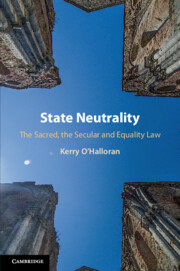Book contents
- State Neutrality
- State Neutrality
- Copyright page
- Dedication
- Contents
- Acknowledgements
- Introduction
- Part I Background
- Part II The Benchmark of State Neutrality
- 4 The United States of America: The Church–State Wall
- 5 Canada: Bijuralism
- 6 England: The Established Church
- 7 France: Laïcité
- 8 Germany: The Vaterland
- 9 Israel: Halakha and Zionism
- Part III Towards a More Stable Civil Society
- Conclusion
- Index
9 - Israel: Halakha and Zionism
from Part II - The Benchmark of State Neutrality
Published online by Cambridge University Press: 15 January 2021
- State Neutrality
- State Neutrality
- Copyright page
- Dedication
- Contents
- Acknowledgements
- Introduction
- Part I Background
- Part II The Benchmark of State Neutrality
- 4 The United States of America: The Church–State Wall
- 5 Canada: Bijuralism
- 6 England: The Established Church
- 7 France: Laïcité
- 8 Germany: The Vaterland
- 9 Israel: Halakha and Zionism
- Part III Towards a More Stable Civil Society
- Conclusion
- Index
Summary
It begins with preliminary matters: an opening section dealing with policy context and related guiding principles, then an outline of the governing legal framework, international and domestic legislation, courts and regulatory bodies, with some references to international reports. This leads into the first of two contemporary case law sections, which examines the state–religion relationship in relation to the most relevant fundamental human rights: the freedoms of religion, assembly/association and expression. The second and largest considers the church–state relationship as it intersects with equality rights in relation to: marriage, family life, divorce and death; healthcare; education; employment; service provision; and security.
- Type
- Chapter
- Information
- State NeutralityThe Sacred, the Secular and Equality Law, pp. 398 - 446Publisher: Cambridge University PressPrint publication year: 2021

